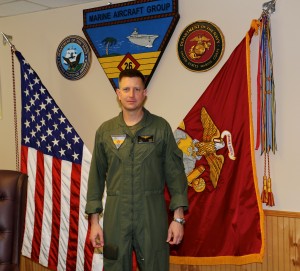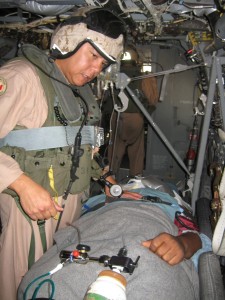During the visit of the Second Line of Defense team to New River on February 10, 2014, we had a chance to sit down with Lt. Col. Ennis to discuss his experience with the Osprey, and preparing for operational innovations, such as CASEVAC.
We also discussed his preparation for working with the CH-53K program.

Lt. Col. Ennis has been with the Osprey program for a considerable period of time, from 2003. He was part of VMX-22 and worked with the introduction of the Osprey into USMC operations. He is becoming the government’s flight test director.
He will be bringing his Osprey experience to the K test program and he noted that one area where the MV-22 is very good and the CH-53 is not is with regard to brownout situations.
The Osprey has a good capability to land in a brownout situation whereas the CH-53Es currently would rather encounter the enemy than deal with a brownout situation.
They would rather land right next to a compound that has a known enemy as opposed to land in open desert.
He also described his experience of going from test pilot to operational experience in Afghanistan and its importance to the evolution of the aircraft itself.
They are a lot of things the test community is working on that are not necessarily the focus of the actual fleet which is deployed.
This gap needs to be closed.
During his time in Afghanistan last year, he was involved in shaping a MEDEVAC role for the Osprey.
Clearly, the advantage of the Osprey over current Army rotorcraft is the ability to operate over a much broader range without the significant Forward Operating Base infrastructure required by the Army medevac approach.
He described that in a situation where there are many troops and FOBs, the current US Army approach works well and operates largely in a 40 nautical mile radius.
When forces are dispersed and one does not have a large support infrastructure, the situation is different and the Osprey can perform the MEDEVAC mission over a much larger area without a significant FOB infrastructure.
We put Ospreys in two different locations to cover an operating area. The two can cover the area in between if they pick up from one location and drop to the other.
We went out to something like 160 nautical miles because if you can fly between point A and point B, it is basically a big ellipse which works out to a distance of 160 nautical miles.
The Osprey can be fitted nicely with the MEDEVAC gear as well.
If you put every litter in the back it can hold 12 patients, but that is not ideal.
You would prefer six so that you can have the medical staff and support gear spaced out.
Normally, you would strap the gurneys to the floor, rather than use litters, because at that point you can work all around the patients.
Outfitted for a MEDEVAC operation the seats fold up and the litters stack up against the walls.
Notably, the USMC prepared for the possible use of the Osprey in the MEDEVAC role for the very beginning of its deployment history.

Now, the possibility should become a reality to transform the capabilities for MEDEVAC operations intra-theater.
Editor’s Note: For the Video Above:
02/23/2014: U.S. Marines and Navy Corpsmen with 2nd Marine Aircraft (Forward) conduct a casualty evacuation (CASEVAC) rehearsal from Helmand Province, Afghanistan on March 31, 2013. The rehearsal was executed in order to train and prepare Marines and Sailors for a real CASEVAC scenario.
The Osprey provides significant advantages versus helos for medevac missions. The Ospreys reach and range allow it to operate from a single base and cover territory, which several Forward Operating Bases would be needed to execute the same mission. And the LZ flexibility of the plane provides greater security than does a helo.
Credit:2nd MAW Forward:3/31/13
An earlier piece focused on how the Marines have been preparing for this role since the initial deployment of the aircraft:
https://sldinfo.com/the-usmc-path-to-innovation-the-osprey-and-medical-evacuation/
Already in 2008, the Marines had incorporated the MV-22 into battlefield medical evacuation. The manual adds the training for the MV-22 to the range of capabilities, which can support the medical evacuation mission.
Tilt-rotor aircraft that takes off and lands vertically but flies like a plane. This aircraft is designed to eventually replace the CH-46.
– When configured for litter racks, able to carry 12 litters or 24 ambulatory casualties.
NOTE: The Marine Corps does not have dedicated CASEVAC aircraft. Any of its aircraft can be utilized as a “lift of opportunity” upon completion of its primary mission.
UNITED STATES MARINE CORPS: Field Medical Training Battalion Camp Lejeune
FMST 1423: Coordinate Casualty Evacuation
http://www.operationalmedicine.org/TextbookFiles/FMST_20008/FMST_1423.htm
In short, you get the new technology into play, use it, and train to the mission.
That is key method whereby innovation occurs for a combat force.
The story below highlights the first medical evacuation conducted by the Osprey from Sea:
MV-22 Ospreys Conduct First-Ever Medical Evacuation
22nd Marine Expeditionary Unit
Courtesy Story
Thursday, June 6, 2009
USS BATAAN, at Sea — The 22nd Marine Expeditionary Unit made history by using two MV-22B Ospreys, assigned to Marine Medium Tiltrotor Squadron 263, to conduct a ship-to-shore emergency medical evacuation of a Sailor from USS Bataan, June 25.
This is the first time the aircraft has been used to conduct such a mission from the sea.
At approximately 4:30 p.m., two Ospreys were returning to Bataan after a routine mission when the pilots were notified of an emergency situation. The aircraft were ordered to return to the ship at maximum speed.
After landing aboard Bataan, the patient and team of medical personnel were brought aboard the aircraft and lifted off at 4:50 p.m. from Bataan’s flight deck. The aircraft travelled 147 nautical miles in 37 minutes to a regional airport where an ambulance was used to transfer the Sailor to a hospital for further treatment.
The Sailor sustained head and hip injuries as well as chest pains after falling. The Sailor is in stable condition in the U.S. Central Command area awaiting further transfer.
“Everybody from the ship made this very easy for us,” said Maj. Brett A. Hart, assistant operations officer for VMM 263 and one of the pilots on the mission. “It was an all-hands effort and everybody gave their utmost to ensure the safety of this Sailor.”
Hart, who has had experience in conducting MEDEVACS in other aircraft like the CH-46E Sea Knight, said the biggest difference with using the Osprey was the rapid speed with which the mission was executed.
“By virtue of having this aircraft, we were able to do it much faster and farther,” he said. “This is a fine example of why we have an aircraft like this.”
The 22nd MEU deployed, May 15, aboard ships from the Bataan Amphibious Ready Group and is currently deployed to the U.S. 5th Fleet area of operations.
The 22nd Marine Expeditionary Unit is a multi-purpose force of more than 2,200 Marines and Sailors. Led by Col. Gareth F. Brandl, the 22nd MEU is composed of its Ground Combat Element, Battalion Landing Team, 3rd Battalion, 2nd Marine Regiment; Aviation Combat Element, VMM-263; Logistics Combat Element, Combat Logistics Battalion 22; and its Command Element.

